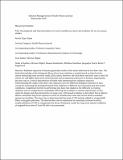| dc.contributor.author | Davidson, Matthew Allen | |
| dc.contributor.author | Hembrador, Sheena | |
| dc.contributor.author | Olipitz, Werner | |
| dc.contributor.author | Yanch, Jacquelyn C | |
| dc.contributor.author | Engelward, Bevin P | |
| dc.date.accessioned | 2010-12-03T15:48:45Z | |
| dc.date.available | 2010-12-03T15:48:45Z | |
| dc.date.issued | 2010-05 | |
| dc.identifier.issn | 0017-9078 | |
| dc.identifier.uri | http://hdl.handle.net/1721.1/60076 | |
| dc.description.abstract | Radiation exposure of humans generally results in low doses delivered at low dose rate. Our limited knowledge of the biological effects of low dose radiation is mainly based on data from the atomic bomb Life Span Study (LSS) cohort. However, the total doses and dose rates in the LSS cohort are still higher than most environmental and occupational exposures in humans. Importantly, the dose rate is a critical determinant of health risks stemming from radiation exposure. Understanding the shape of the dose-rate response curve for different biological outcomes is thus crucial for projecting the biological hazard from radiation in different environmental and man-made conditions. A significant barrier to performing low dose-rate studies is the difficulty in creating radiation source configurations compatible with long-term cellular or animal experiments. In this study the design and characterization of a large area, 125I-based irradiator is described. The irradiator allows continuous long-term exposure of mice at variable dose rates and can be sited in standard animal care facilities. The dose rate is determined by the level of 125I activity added to a large NaOH-filled rectangular phantom. The desired dose rate is maintained at essentially constant levels by weekly additions of 125I to compensate for decay. Dosimetry results for long-term animal irradiation at targeted dose rates of 0.00021 and 0.0021 cGy min−1 are presented. | en_US |
| dc.description.sponsorship | United States. Dept. of Energy (Grant FG01-04ER04-21) | en_US |
| dc.description.sponsorship | University of California, Davis. Center for Environmental Health Sciences (P30 ES001209-26A1) | en_US |
| dc.description.sponsorship | National Institutes of Health (U.S.) (NIH R01-CA79827) | en_US |
| dc.description.sponsorship | Austrian Academy of Sciences | en_US |
| dc.language.iso | en_US | |
| dc.publisher | Health Physics Society | en_US |
| dc.relation.isversionof | http://dx.doi.org/10.1097/HP.0b013e3181d26dc5 | en_US |
| dc.rights | Attribution-Noncommercial-Share Alike 3.0 Unported | en_US |
| dc.rights.uri | http://creativecommons.org/licenses/by-nc-sa/3.0/ | en_US |
| dc.source | prof. Engelward via Howard Silver | en_US |
| dc.title | Development and characterization of a novel variable low-dose rate irradiator for in vivo mouse studies | en_US |
| dc.type | Article | en_US |
| dc.identifier.citation | Olipitz, Werner et al. “Development and Characterization of A Novel Variable Low Dose-Rate Irradiator for in Vivo Mouse Studies.” Health Physics 98.5 (2010): 727-734
10.1097/HP.0b013e3181d26dc5. | en_US |
| dc.contributor.department | Massachusetts Institute of Technology. Department of Biological Engineering | en_US |
| dc.contributor.department | Massachusetts Institute of Technology. Department of Nuclear Science and Engineering | en_US |
| dc.contributor.approver | Engelward, Bevin P. | |
| dc.contributor.mitauthor | Olipitz, Werner | |
| dc.contributor.mitauthor | Hembrador, Sheena | |
| dc.contributor.mitauthor | Davidson, Matthew Allen | |
| dc.contributor.mitauthor | Yanch, Jacquelyn C. | |
| dc.contributor.mitauthor | Engelward, Bevin P. | |
| dc.relation.journal | Health Physics | en_US |
| dc.eprint.version | Author's final manuscript | |
| dc.type.uri | http://purl.org/eprint/type/JournalArticle | en_US |
| eprint.status | http://purl.org/eprint/status/PeerReviewed | en_US |
| dspace.orderedauthors | Olipitz, Werner; Hembrador, Sheena; Davidson, Matthew; Yanch, Jacquelyn C.; Engelward, Bevin P. | en |
| mit.license | OPEN_ACCESS_POLICY | en_US |
| mit.metadata.status | Complete | |
